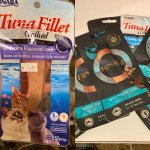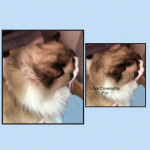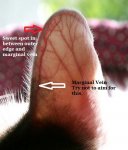Katherine&Ruby
Very Active Member
Hello and allow me to introduce ourselves! I'm Katherine and my soulkitty Ruby was diagnosed a little over a month ago after I took her to the vet because she was losing weight and not eating. She had DKA and it's been quite an emotional (not to mention extremely expensive) journey since then! She spent three nights at Blue Pearl here in New York and got what I hope is the best care she can get.
Since arriving home, we've changed a lot of things:
-New litter box for Ketodiastix testing (Smart Cat Litter Box with the convenient pee drawer using Tidy Cat Breeze pellets--an amazing system that I wish I discovered ages ago!)
-Switch from predominantly dry food (Solid Gold Let's Stay Indoors)/small portion wet (Solid Gold Tuna and Mackerel) to predominantly wet food (Purina DM)/small portion dry (Hill's Glucosupport). I keep the dry food as a topping to encourage her to eat before her shots.
-Sure Feed Microchip Feeders acquired to keep her prescription food separate from her healthy sister Olive's less expensive and tastier food.
At the beginning, Ruby was started on 1 unit of Lantus twice a day. We brought her back to the vet 7 days later and had a Freestyle Libre installed on her back that she hated and scratched at until it fell off 7 days after implanting. Using the results from that, Ketodiastix indicating trace ketones high glucose levels, and the fact that she remained in bed sleeping almost all the time, the vet did a blood test and upped her dosage to 1.5 units per dose about two weeks ago. This week, I started to see some results: Ruby is noticeably more energetic, she is jumping on tables and windowsills and is chasing her sister around the apartment. She is also spending less time in bed. However, her Ketodiastix still show high glucose and trace ketones.
The vet would like for me to send her back next week to install another Freestyle Libre. I don't want to do this as it's expensive to buy, expensive for the vet to implant it, and doesn't last for 14 days as she will scratch it off before then. Plus, the presence of the sensor makes Ruby miserable. The vet has NOT advised me to test blood glucose at home. Should I be doing this instead of the Libre? I see so much information on home testing here but I'm wary of pricking her all day long.
So happy to have found this forum through a suggestion from the r/Cats forum on Reddit. Wish I had discovered this community sooner!
Since arriving home, we've changed a lot of things:
-New litter box for Ketodiastix testing (Smart Cat Litter Box with the convenient pee drawer using Tidy Cat Breeze pellets--an amazing system that I wish I discovered ages ago!)
-Switch from predominantly dry food (Solid Gold Let's Stay Indoors)/small portion wet (Solid Gold Tuna and Mackerel) to predominantly wet food (Purina DM)/small portion dry (Hill's Glucosupport). I keep the dry food as a topping to encourage her to eat before her shots.
-Sure Feed Microchip Feeders acquired to keep her prescription food separate from her healthy sister Olive's less expensive and tastier food.
At the beginning, Ruby was started on 1 unit of Lantus twice a day. We brought her back to the vet 7 days later and had a Freestyle Libre installed on her back that she hated and scratched at until it fell off 7 days after implanting. Using the results from that, Ketodiastix indicating trace ketones high glucose levels, and the fact that she remained in bed sleeping almost all the time, the vet did a blood test and upped her dosage to 1.5 units per dose about two weeks ago. This week, I started to see some results: Ruby is noticeably more energetic, she is jumping on tables and windowsills and is chasing her sister around the apartment. She is also spending less time in bed. However, her Ketodiastix still show high glucose and trace ketones.
The vet would like for me to send her back next week to install another Freestyle Libre. I don't want to do this as it's expensive to buy, expensive for the vet to implant it, and doesn't last for 14 days as she will scratch it off before then. Plus, the presence of the sensor makes Ruby miserable. The vet has NOT advised me to test blood glucose at home. Should I be doing this instead of the Libre? I see so much information on home testing here but I'm wary of pricking her all day long.
So happy to have found this forum through a suggestion from the r/Cats forum on Reddit. Wish I had discovered this community sooner!














